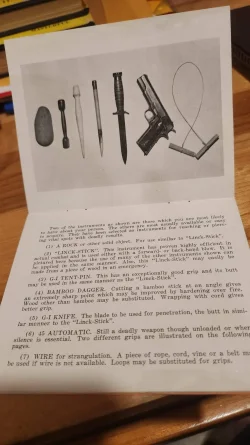THE HAMMER GRIP
This term was coined by the late Col. Rex Applegate in his classic work Kill or Get Killed. To assume this grip, simply make a fist around the handle of the knife with the blade extending from the thumb side of the hand. Curl the thumb down and squeeze the hand tight.
The hammer grip is a very strong grip that is great for weapon retention and management of impact shock, and many knife practitioners use it exclusively. However, its focus on strength can sometimes compromise speed and maneuverability.
Get a Grip!: A Complete Guide To Knife Grips - SWAT Survival | Weapons | Tactics The above description is written by an acknowledged expert, Michael Janich. I train regularly with one of his instructors and have met and had face to face discussions with Mike Janich. As he mentions, the term was coined by Rex Applegate, a legend in the military combatives, shooting and knife worlds. I have trained with a direct student of Rex Applegate.
I have trained off and on for the last twenty years with Craig Douglas. He also advocates for the hammer grip, often in the reverse grip, or icepick configuration.
Don Pentecost, author off Put 'em down, Take 'em out! Knife fighting techniques from Folsom Prison call the hammer grip the hit grip. This is how he describes it. HIT Grip. The hit grip is primarily for penetration. It is the preferred grip for serious business. The hand is wrapped around the handle into a fist, with the blade extended from the top of the hand, between the thumb and index finger. Your thumb is the key element for a secure grip.
Why do acknowledged experts in military knife fighting, FMA and prison knife fighting all advocate the hammer grip? Could it be because it provides the most secure grip you can have on a knife without a guard, or an improvised weapon with an inadequate handle? Could it be because it is an instinctive grip that doesn't require a lot (or any)training to make work? I have been taught by multiple instructors that to combine a hammer grip with a locked wrist essentially creates a piston with a blade on the end. If you are doing point-oriented knife work, a hammer grip makes a lot of sense.

